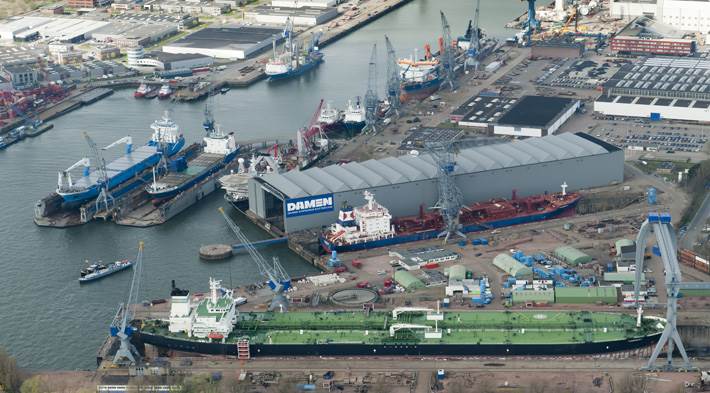
European shipbuilding group Damen has unveiled a section of an ocean-going hull made by composites, potentially leading to ships that are 40% lighter than today’s steel versions.
The hull section, built at Damen Schelde Naval Shipbuilding, will now go for testing.
In a release, Damen claimed the revolutionary new composite ship design can offer a reduction in global warming potential, aerosol formation potential, eutrophication potential, acidification potential and fuel consumption by up to 25%.
Current regulations only allow for composite vessels of up to 500 tonnnes or 25 m in length.
Damen and its partners aim to address this by scaling up the composite technology and capacity to design, produce and market composite vessels up to 85 m long in full compliance with Safety of Life at Sea (SOLAS) and class regulations by validating the production process of large composite structures with economic improvement and key performance indicators for fire-resistance, impact resistance and structural robustness.
Classification society Bureau Veritas is involved in the project and funding has come from the European Union.
“The work we are doing here is important for the future of shipping. Sustainability is a major focus in industry right now and shipbuilding is no exception,” said Marcel Elenbaas, a senior engineer at DSNS. “The use of composites for larger ships has significant consequences for the entire design of the ship. If it is lighter, a vessel uses less fuel and produces lower emissions. The vessel also requires smaller engines, which means more space for additional systems, making for a more versatile platform. And of course, composites require considerably less maintenance than a steel vessel.”

Great.
Now recycle it.
Dunno but impact resistance and composite materials, me thinks, can only go together in one direction. Point impacts on any other direction than that of the design would create fractures or catastrophic failure. Beef it up enough and it becomes economically and operationally problematic. Not to mention the recycling which is practically not possible. Marketing ploy? Next thing will be a VLCC entirely made by Dyneema?
The thing about materials is that you need to know what to apply where. Although it is possible to build crude oil tanks in composites, a VLCC would clearly not be the first application. Composites are great, however, since they can be pretty much designed to optimally suit the loads of the particular structure you need. Navies have designed, tested, built and operated mine countermeasures vessels in the 50-80m range for a very long time, so impact resistance is perhaps not the biggest issue. Considering also the several European initiatives aiming at lightweight and fuel saving marine structures which have existed for quite a while, it is not really fair to assume it is about marketing or fund raising. I think composites in commercial vessels are maturing and deserve a good look before dismissed.
And yes, recycling is difficult, but on the other hand the service life is longer and a composite hull will probably not end up at a Beach in Bangladesh, which is a significant improvement on steel hulls.
Good way for Damen to get state funds. Modern begging is like this.